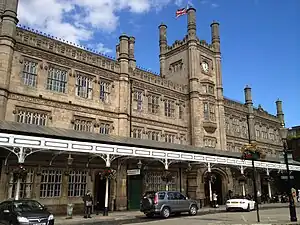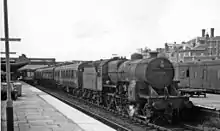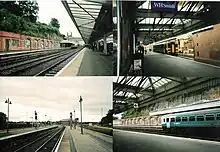Shrewsbury | |
|---|---|
 Shrewsbury station frontage | |
| General information | |
| Location | Shrewsbury, Shropshire England |
| Grid reference | SJ494129 |
| Managed by | Transport for Wales |
| Line(s) | Welsh Marches Wolverhampton–Shrewsbury Shrewsbury–Chester Cambrian |
| Platforms | 5 (numbered 3-7) |
| Other information | |
| Station code | SHR |
| Classification | DfT category C1 |
| Key dates | |
| 1848 | Opened |
| Passengers | |
| 2018/19 | |
| Interchange | |
| 2019/20 | |
| Interchange | |
| 2020/21 | |
| Interchange | |
| 2021/22 | |
| Interchange | |
| 2022/23 | |
| Interchange | |
| Location | |
| Notes | |
Passenger statistics from the Office of Rail and Road | |


Shrewsbury railway station is in Shrewsbury, Shropshire, England. Built in 1848, it was designated a grade II listed building in 1969.
The station is 43 miles (69 km) north west of Birmingham New Street. Many services starting at or passing through the station are bound for Wales, and it is a key hub for its operator, Transport for Wales. Services are also provided by Avanti West Coast and West Midlands Railway.
History
The station was formerly known as Shrewsbury General and is the only remaining railway station in the town; Shrewsbury Abbey, as well as other small stations around the town, having long closed.
Shrewsbury railway station was originally built in October 1848 for the county's first railway — the Shrewsbury to Chester Line. The architect was Thomas Mainwaring Penson of Oswestry[1] and the contractor was Thomas Brassey.[2] The building is unusual, in that the station was extended between 1899 and 1903 by the construction of a new floor underneath the original station building.[1] The building style was imitation Tudor, complete with carvings of Tudor style heads around the window frames. This was done to match the Tudor building of Shrewsbury School (now Shrewsbury Library) almost directly opposite and uphill from the station. The station's platforms also extend over the River Severn. It was operated jointly by the Great Western Railway (GWR) and the London and North Western Railway (LNWR).[3]
At Shrewsbury in steam days, the GWR regularly turned its locomotives by running round the triangle formed by using the Abbey Foregate loop, which links the Wolverhampton Line with the Welsh Marches Line and enables through running for freight trains, summer Saturday specials and formerly for trains like the Cambrian Coast Express. Until 1967 Shrewsbury was served by the GWR, latterly BR Western Region, express services between London Paddington and Birkenhead Woodside railway station.
The station was given Grade II listed status in May 1969;[1] this applies to the main building on Castle Foregate, adjacent to platform 3.
Arwel Hughes composed Tydi a roddaist in 20 minutes during a wait between train connections in 1938. A plaque to mark this was unveiled on platform 3 in 2004.[4]
Accidents and incidents
- On the 15 October 1907, a mail train hauled by Experiment class locomotive No. 2052 Stephenson was derailed at Shrewsbury due to excessive speed on a curve. Eighteen people were killed.[5]
- On the 6 November 2017, an Arriva Trains Wales Class 175 DMU, numbered 175109, caught fire, causing the station to be evacuated for approximately two hours. There were no casualties but significant travel disruption occurred.[6]
Signalling

Severn Bridge Junction signal box, at the south east end of the station and built by the LNWR, is the largest surviving mechanical signal box in the world, with a frame accommodating 180 levers, and is a listed building. Whilst the line beyond Abbey Foregate signal box to Wolverhampton has been updated to electronic signalling, Shrewsbury itself is set to remain lever operated for the foreseeable future.[7] As a result of Shrewsbury's joint (GWR/LNWR) history, and having been transferred at different times between the Western and London Midland regions of BR and more recently Network Rail - it is now in the Great Western territory again - the signalling is a diverse mixture of lower-quadrant and upper-quadrant semaphore signals, with a few colour lights too. Crewe Junction, on the north end of the station, accommodates around 120 levers and is of the same design as Severn Bridge Junction.
The other Shrewsbury signal boxes are at Abbey Foregate (to a GWR design), controlling the eastern corner of the triangle and Sutton Bridge Junction where the Aberystwyth line diverges from the Hereford line (the now closed Severn Valley Railway to Bridgnorth and Hartlebury also left the main line there).
Two other boxes at Crewe Bank and Harlescott Crossing (slightly further on towards Crewe) were both abolished (and subsequently removed) in October 2013, when the Crewe line had its signalling replaced by a new modular system controlled from the South Wales Rail Operating Centre in Cardiff.[8] The former box had been "switched out" of use for several years previously and had been proposed for abolition by Network Rail back in 2009.[9]
In autumn 2010 changes were made to allow Cambrian and Welsh Marches line trains to depart in a southerly direction from Platform 3. An upper quadrant signal replaced the previous shunting disc and a facing point lock was added to the points. Though the track layout could already accommodate this, until the lock was added only non-passenger movements southbound from Platform 3 could be made.[10] Platforms and facilities
Shrewsbury railway station | |||||||||||||||||||||||||||||||||||||||||||||||||||||||||||||||||||||||||||||
|---|---|---|---|---|---|---|---|---|---|---|---|---|---|---|---|---|---|---|---|---|---|---|---|---|---|---|---|---|---|---|---|---|---|---|---|---|---|---|---|---|---|---|---|---|---|---|---|---|---|---|---|---|---|---|---|---|---|---|---|---|---|---|---|---|---|---|---|---|---|---|---|---|---|---|---|---|---|
| |||||||||||||||||||||||||||||||||||||||||||||||||||||||||||||||||||||||||||||
There are five platforms in use, numbered 3 to 7 (platforms 1 and 2 have been disused since the 1980s and have no track; around 2019 platform 2 was dismantled). Of these, platforms 4, 5, 6 and 7 are grouped on a main island, while platforms 1, 2 and 3 are separate, located by the main station building. The platforms are numbered in order from west (Shrewsbury Castle side) to east (The Dana side) from 1 to 7.
Platform 3 was until recently only used by trains running in from the Wolverhampton direction and out towards Chester. Changes made in 2010 to the signalling and track now allow additional passenger trains (those coming in from and going out to the Hereford, Heart of Wales and Cambrian lines) to use platform 3. A passenger lift was opened on the platform in 2009 and a waiting room opened shortly after. A lift has also been built for access to platforms 4–7, making the station fully accessible for wheelchair and mobility-impaired users.
Platforms 4 and 7 are through platforms, usually used for trains between Holyhead (via Chester and Wrexham General) and Cardiff Central/Birmingham International and between Manchester Piccadilly (via Crewe) and Cardiff Central, Carmarthen, and Milford Haven. Platforms 5 and 6 are bay platforms, used mainly for trains to and from Aberystwyth and Birmingham, as well as trains for the Heart of Wales Line and local stopping trains to Birmingham New Street.
The island platforms are connected to the main station building and platform 3 by a pedestrian subway running underneath the station. A pedestrian footbridge over the platforms still exists but has long been disconnected from the station; instead, it is a public walkway allowing pedestrians to cross over the station area, and part of a route named "The Dana". All platforms are fitted with CIS screens and automatic announcement speakers and there are customer help points on platforms 3 and 4. A buffet, toilets, and vending machines selling snacks and drinks are sited between platforms 4 and 7.[11]
Ticket gates are in operation at the entrance to platforms 4 to 7, with the adjacent ticket office staffed throughout the week. Self-service ticket machines are also available for buying tickets or collecting tickets for pre-booked journeys.[11]
Opposite platform 7 is a high concrete wall that divides the rest of the station from what could be considered to be platform 8. This platform does not see any use and was built for the use of transporting prisoners from HM Prison Shrewsbury. (The prison gateway, surmounted by bust of prison reformer John Howard, is visible from platform 7.) It is believed that this platform was only used a few times each year between 1868 up until just before the First World War.
Station usage
According to the Office of Rail Regulation statistics for the 2011/12 financial year, the total number of entries and exits at the station was 1,730,390 (based on tickets sold at Shrewsbury, and tickets sold to Shrewsbury); with an estimated 205,148 passengers interchanging between services. This makes Shrewsbury the 14th busiest in the West Midlands region and the 6th busiest on the Transport for Wales network.[12]
Services
Railway lines in Shrewsbury | ||||||||||||||||||||||||||||||||||||||||||||||||||||||||
|---|---|---|---|---|---|---|---|---|---|---|---|---|---|---|---|---|---|---|---|---|---|---|---|---|---|---|---|---|---|---|---|---|---|---|---|---|---|---|---|---|---|---|---|---|---|---|---|---|---|---|---|---|---|---|---|---|
| ||||||||||||||||||||||||||||||||||||||||||||||||||||||||
Transport for Wales
- Alternate hourly service from Holyhead via Chester and Wrexham General to Birmingham International or Cardiff Central.[13]
- Two-hourly services from Aberystwyth and Pwllheli via the Cambrian Line to Birmingham International which merge at Machynlleth.[14] Some additional Aberystwyth trains start and finish here at certain times of day. Some late evening services also terminate at Machynlleth.
- Hourly services from Manchester Piccadilly to Cardiff Central via the Welsh Marches Line. Most services on this route extend to Swansea and Carmarthen, with through running to Milford Haven every two hours. Some services terminate at Tenby, Maesteg or Pembroke Dock. There is also a two-hourly local stopping service to Crewe on this route.[15]
- Services via the Heart of Wales Line to Swansea. Five trains per day each way Monday–Saturday (plus two services to Llandrindod Wells except Saturdays) and two trains each way on Sundays.[16]
- Locomotive-hauled Premier Service between Holyhead and Cardiff Central via Chester. Three trains each way per day.
- Local Stopping services to Wrexham General (morning & late evening only)
All of the services above are operated by Class 150s, Class 153s, Class 158s or Class 175s, except the Premier Service which is operated by a Class 67 and Mark 4 coaching stock.
West Midlands Railway
- Hourly stopping service to Birmingham New Street, operated by Class 196s, from Monday to Sunday
- Hourly limited stopping service to Birmingham New Street, calling at Wellington, Telford, Shifnal, Codsall and Wolverhampton.[17][18][19]
Avanti West Coast
- One daily service to and from London Euston via Birmingham New Street and Coventry, operated by Class 221s.[20][21][22]
See also
References
- 1 2 3
"HER no. 10126 - Shrewsbury Railway Station, Castle Foregate, Shrewsbury". Heritage Gateway. English Heritage. Retrieved 13 March 2010.
A railway station built in 1849, and extended circa 1900, which is protected by Grade II Listing. The station became very congested in the later 19th century and was extensively rebuilt between 1899 and 1903 to cope with increased traffic. The bridge was widened, and the platforms extended onto it, and a basement story added.
- ↑ "A Guide, Descriptive and Hhistorical, Through the Town of Shrewsbury". Gutenburg. 1855. Retrieved 28 August 2023.
- ↑ Denton, John Horsley (1986). Shrewsbury Railway Station: a brief history. Welshpool: J.H. Denton & T. Smith.
- ↑ Shropshire War Memorials, Sites of Remembrance. p. 194.
- ↑ Trevena, Arthur (1980). Trains in Trouble. Vol. 1. Redruth: Atlantic Books. p. 24. ISBN 0-906899-01-X.
- ↑ Rowden, Nathan. "Trains cancelled and delayed after Shrewsbury Railway Station blaze drama - with pictures and video". www.shropshirestar.com. Retrieved 8 November 2017.
- ↑ "Signal boxes removed and updated". BBC News. 1 October 2006.
- ↑ Shrewsbury – Crewe Modular Re-Signalling Pilot Network Rail Consulting Projects site; Retrieved 3 August 2017
- ↑ "ncg12007west409v1 crewe bank - closure of signal box" (PDF). Network Rail.
- ↑ "Adrian the Rock - Signals at Severn Bridge Junction". Roscalen.com. Retrieved 25 July 2017.
- 1 2 Shrewsbury Station National Rail Enquiries
- ↑ "Estimates of station usage" (XLS). Rail statistics. Office of Rail Regulation. Retrieved 5 April 2013.
- ↑ GB eNRT December 2022 Edition, Tables 75 & 131
- ↑ GB eNRT December 2022 Edition, Table 75
- ↑ GB eNRT December 2022 Edition, Table 131
- ↑ Table 130 National Rail timetable, December 2022
- ↑ "'Major' rail changes in timetable overhaul". BBC News. 19 May 2019. Retrieved 24 July 2019.
- ↑ O'Brien, Lisa (13 March 2019). "New timetable includes later rail services between Shropshire and West Midlands". The Shropshire Star. Retrieved 24 July 2019.
- ↑ GB eNRT May 2019 Edition, Table 74 (Network Rail)
- ↑ BBC News, https://www.bbc.co.uk/news/uk-england-29313965
- ↑ GB eNRT May 2017 Edition, Table 65
- ↑ "Avanti West Coast 12 September - 11 December 2021 Timetable" (PDF). Avanti West Coast.
Further reading
- Mitchell, Vic; Smith, Keith (2009). Wolverhampton to Shrewsbury. Middleton Press. figs. 111-120. ISBN 9781906008444. OCLC 286385795.
- Mitchell, Vic; Smith, Keith (2007). Kidderminster to Shrewsbury. Middleton Press. figs. 112-120. ISBN 9781906008109. OCLC 154801530.
- Mitchell, Vic; Smith, Keith (2008). Shrewsbury to Ludlow. Middleton Press. figs. 1-12. ISBN 9781906008215. OCLC 520487698.
- Mitchell, Vic; Smith, Keith (2010). Shrewsbury to Chester. Middleton Press. figs. 1-12. ISBN 9781906008703. OCLC 495274299.
External links
- Train times and station information for Shrewsbury railway station from National Rail
- Signalling around Shrewsbury station
- Shrewsbury station on navigable 1946 O.S. map
- Grade II listing entry